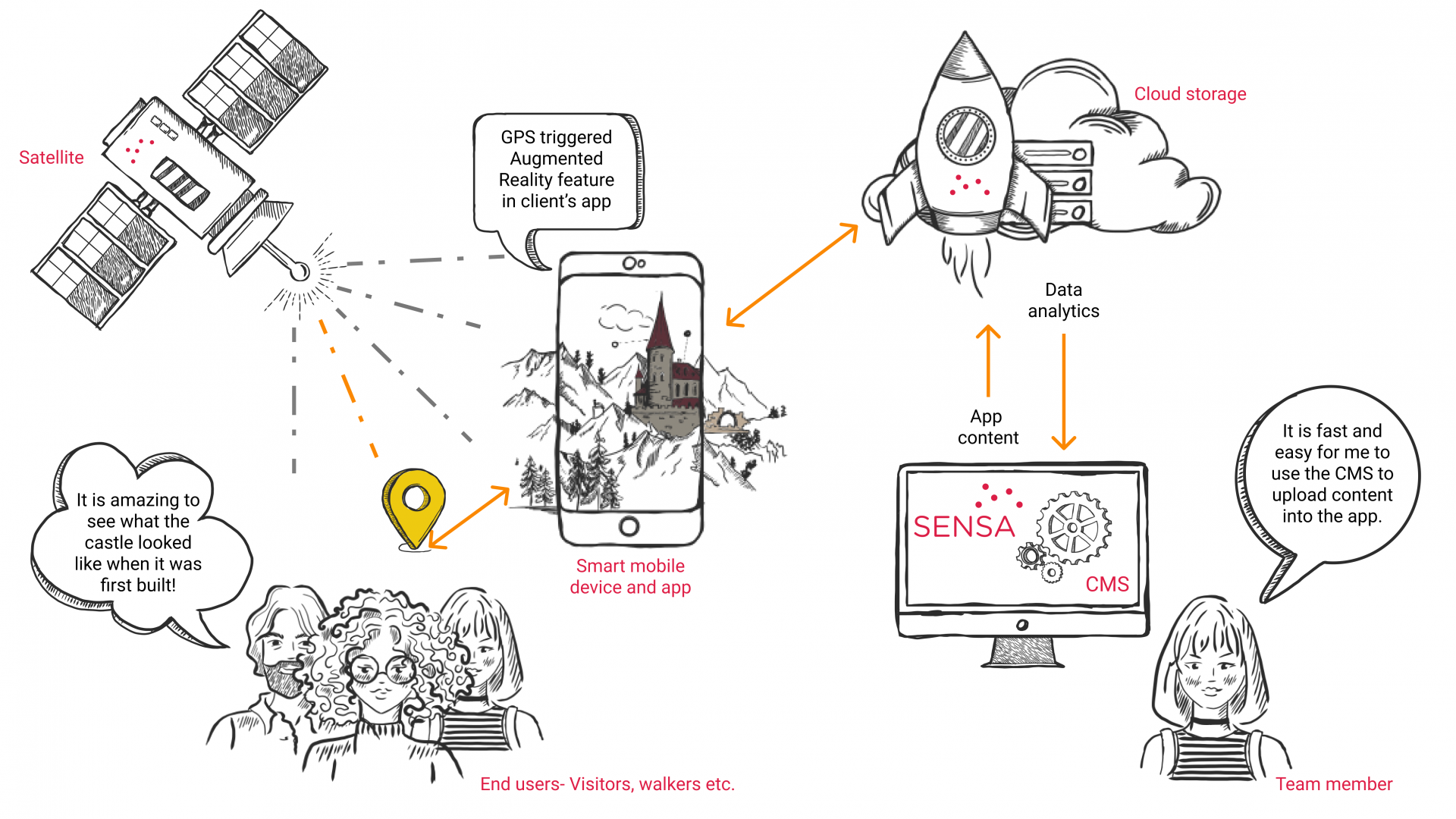
Objectives of the service
Inspired by the Pokémon Go phenomena, and audience expectations to access rich content via their mobile device, organisations are keen to exploit GPS and AR technologies to deliver interactive and targeted visitor experiences. The problem, however, has been the complexity and high cost associated with commissioning this new interface.
Our primary objective was to meet this demand, addressing cost and complexity barriers by creating a GPS triggered AR system that can be easily customised and deployed at an affordable price.
Our new GPS triggered AR system has been developed as a fully customisable and recyclable module as part of SENSA®, Flo-culture’s audience engagement platform. This solution has ensured that more organisations can exploit mobile and space technologies to improve their engagement outcomes.
Imagine you’re looking out across Edinburgh, you’re curious about all the buildings and monuments before you. You hold up your phone, panning the view below. Labels appear hovering above the various places of interest. You tap a label, a voice from the past tells you about the site. You tap another, a short animation shows you what the place would have looked like in the past. You tap another…the content options are endless.
Users and their needs
1. Visitor attractions, publishers and tour operators. Their primary goal is to attract and engage audiences by delivering targeted, relevant experiences for different audience groups. They need to:
- increase visitor presence and revenues
- increase visitor awareness, knowledge and understanding
- meet accessibly and diversity obligations
- achieve positive customer satisfaction ratings
- increase recommendations and repeat visits
Delivering impactful engagement experiences for visitors’ outdoors is operationally challenging. Organisations are reluctant to detract from the principle pleasure of simply being outdoors. Littering sites of special interest with signage that is disruptive, expensive, prone to vandalism and weather damage is not an ideal. Neither is the offer of endless leaflets with limited content that can quickly go out of date, or web content that requires the user to scroll through vast quantities of information to just find the thing that they want.
2. Digital marketing agencies that are looking to provide customers with new mobile offers, including affordable GPS and AR experiences that they can use to improve their engagement outcomes.
Their clients will have similar engagement needs and operational challenges as listed above. In addition, the agencies need digital solutions that can be fully integrated with their mobile digital solutions, customised to align with their clients’ brand requirements.
Service/ system concept
Our new GPS triggered AR system enables users to attach a 3D model, video or image to a GPS location, making it possible for clients to use location-based AR interfaces outdoors.
This new system has been integrated into our existing audience engagement platform SENSA®.
As the visitor approaches a Point of Interest, the GPS receiver in their phone will activate the presentation of a location-specific AR experience on their mobile phone.

Main system building blocks
- Information systems platform – Supports back-office operations, this includes processing and managing the publication of external content (films, audio images) into customer-facing apps. This is where the service user customises and uploads content to be used in the GPS triggered AR feature in their app.
- Customer experience platform – Mobile app. This is how the end-user (visitor) engages with the experience.
- Data platform — Contains information management capabilities, including the main and back-up servers and Mongo DB. This is where the content data is filed and stored.
- Analytics platform - Contains analytical capabilities supported by Flurry Analytics. This is where data relating to downloads, and visitor behaviour and interaction are collected and collated.
Space Added Value
The main space asset we used is Satellite Navigation. Global Navigation Satellite System (GNSS) is the primary source of geo-referenced locations data. We use this data to create interactive walking trails on custom maps in the user’s mobile device. We can attach interpretative digital content to specific places on those routes to enhance user engagement. E.g. using an AR feature to place an image of a castle that has long since disappeared in the landscape the user is exploring.
This means organisations can facilitate visitor engagement without the need to litter the landscape with signage, burden them with leaflets or the requirement that they endlessly search their website to find the relevant piece of information. Furthermore, outdoor signage and leaflets are rather blunt engagement tools as they deliver the same information to everyone no matter their level of interest or physical location. Leaflets and signage are expensive to update and maintain.
In addition, existing GPS /AR combined frameworks are expensive and complex to use. By creating a recyclable module that operates as part of our SENSA® audience engagement platform, we have been able to develop a GPS/AR module that is fast, easy and affordable to deploy.
Current Status
We engaged with existing and potential new clients to determine their needs, undertaking desk and field research, and micro testing. We used this knowledge to inform the development of a new GPS triggered AR system, reviewing this against our clients’ users’ needs. In the main, these needs have been met. However, some aspects need further refinement with clients and end users. We’ve produced a business plan and forecast budget that provides a clear roadmap for future growth.
Current status:
We will use this business plan to direct our activities going forward. In parallel, we plan to submit an ESA Demonstration Project application in Q1-2020 to support:
- the further refinement of our GPS triggered AR module
- real-world deployment and testing
- a clear go-to-market delivery plan
We will consolidate our relationship with strategic partners to secure the partnerships and financial resources required to support an ESA Demonstration Project application.



